M2U1 grammar(教师版) 2
- 格式:doc
- 大小:77.37 KB
- 文档页数:7
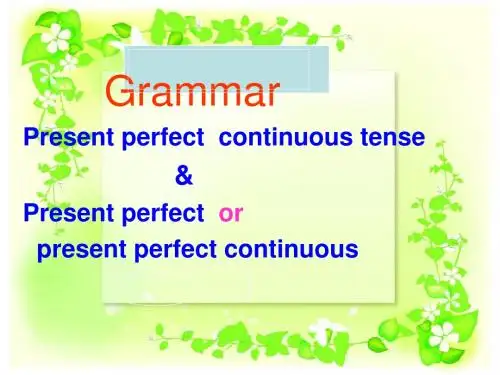
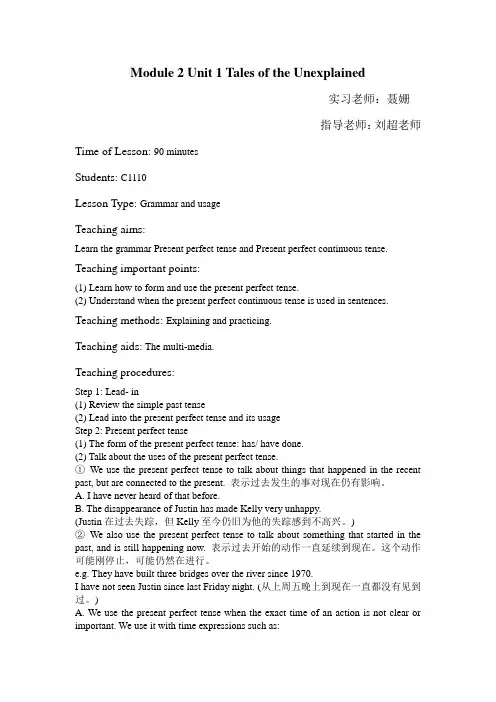
Module 2 Unit 1 Tales of the Unexplained实习老师:聂姗指导老师:刘超老师Time of Lesson: 90 minutesStudents: C1110Lesson Type: Grammar and usageTeaching aims:Learn the grammar Present perfect tense and Present perfect continuous tense. Teaching important points:(1) Learn how to form and use the present perfect tense.(2) Understand when the present perfect continuous tense is used in sentences. Teaching methods: Explaining and practicing.Teaching aids:The multi-media.Teaching procedures:Step 1: Lead- in(1) Review the simple past tense(2) Lead into the present perfect tense and its usageStep 2: Present perfect tense(1) The form of the present perfect tense: has/ have done.(2) Talk about the uses of the present perfect tense.①We use the present perfect tense to talk about things that happened in the recent past, but are connected to the present. 表示过去发生的事对现在仍有影响。
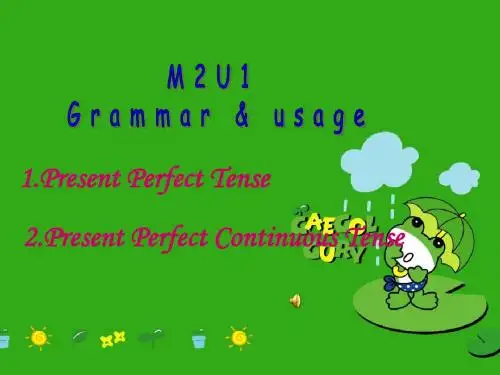
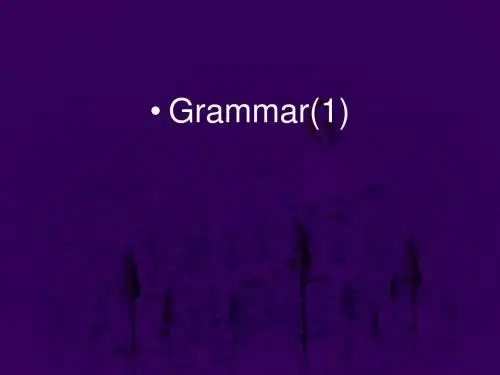



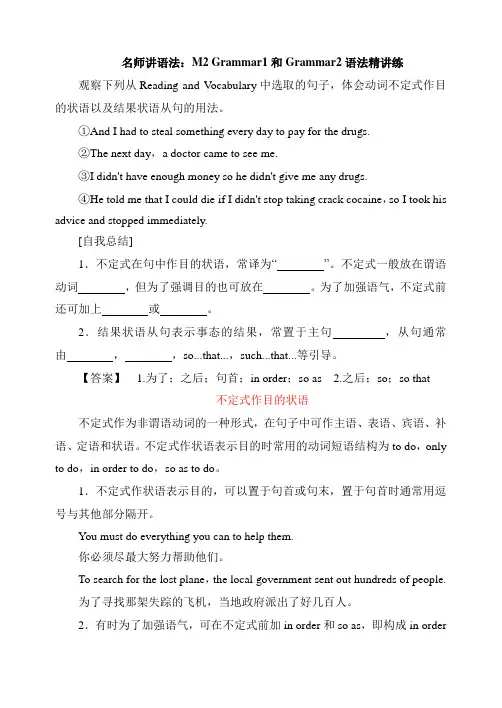
名师讲语法:M2 Grammar1和Grammar2语法精讲练观察下列从Reading and V ocabulary中选取的句子,体会动词不定式作目的状语以及结果状语从句的用法。
①And I had to steal something every day to pay for the drugs.②The next day,a doctor came to see me.③I didn't have enough money so he didn't give me any drugs.④He told me that I could die if I didn't stop taking crack cocaine,so I took his advice and stopped immediately.[自我总结]1.不定式在句中作目的状语,常译为“”。
不定式一般放在谓语动词,但为了强调目的也可放在。
为了加强语气,不定式前还可加上或。
2.结果状语从句表示事态的结果,常置于主句,从句通常由,,so...that...,such...that...等引导。
【答案】 1.为了;之后;句首;in order;so as 2.之后;so;so that不定式作目的状语不定式作为非谓语动词的一种形式,在句子中可作主语、表语、宾语、补语、定语和状语。
不定式作状语表示目的时常用的动词短语结构为to do,only to do,in order to do,so as to do。
1.不定式作状语表示目的,可以置于句首或句末,置于句首时通常用逗号与其他部分隔开。
You must do everything you can to help them.你必须尽最大努力帮助他们。
To search for the lost plane,the local government sent out hundreds of people.为了寻找那架失踪的飞机,当地政府派出了好几百人。
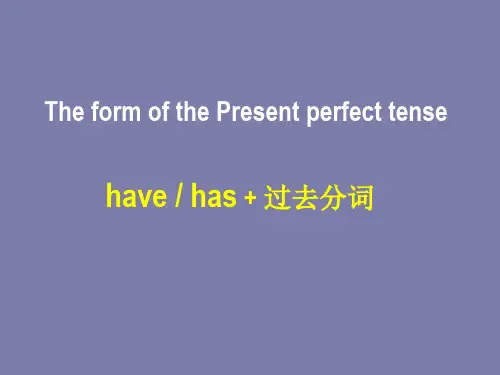
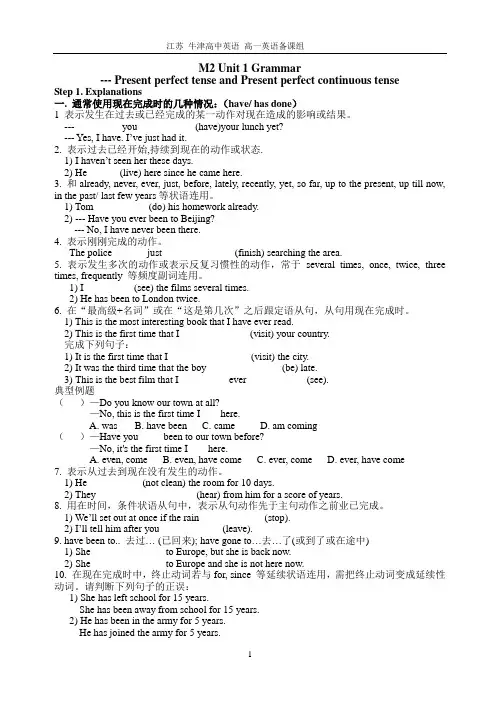
江苏牛津高中英语高一英语备课组M2 Unit 1 Grammar--- Present perfect tense and Present perfect continuous tenseStep 1. Explanations一. 通常使用现在完成时的几种情况:(have/ has done)1 表示发生在过去或已经完成的某一动作对现在造成的影响或结果。
--- ______ __ you _____ _____ (have)your lunch yet?--- Yes, I have. I’ve just had it.2. 表示过去已经开始,持续到现在的动作或状态.1) I haven’t seen her these days.2) He ______(live) here since he came here.3. 和already, never, ever, just, before, lately, recently, yet, so far, up to the present, up till now, in the past/ last few years等状语连用。
1) Tom __________ (do) his homework already.2) --- Have you ever been to Beijing?--- No, I have never been there.4. 表示刚刚完成的动作。
The police ______ just ________ _____ (finish) searching the area.5. 表示发生多次的动作或表示反复习惯性的动作,常于several times, once, twice, three times, frequently 等频度副词连用。
1) I _________ (see) the films several times.2) He has been to London twice.6. 在“最高级+名词”或在“这是第几次”之后跟定语从句,从句用现在完成时。
Module 2 Unit 1 Tales of the unexplained Period 3 GrammarPresent perfect tense&Present perfect continuous tense【学习目标】 1.掌握现在完成时和现在完成进行时的用法。
2.区分现在完成时和一般过去时及现在完成时和现在完成进行时。
【知识线索】 现在完成时是一种既涉及过去又联系现在的时态。
现在完成进行时是动作开始于过去,持续到现在,有可能还会延续下去的时态。
1.He has lived in Beijing for ten years.2.I have already seen the film.3.He has been learning English for 6 years.4.I have been looking for you everywhere.【知识构建】现在完成时:1.现在完成时的构成:肯定句_________________否定句______________ 疑问句______________主语( I/We/You/They) + ______ +过去分词主语(He/She/It) + _______ +过去分词Keys: have/has +过去分词;have/has + not +过去分词;Have/Has +主语+过去分词......?;have; has2.现在完成时的用法:⑴ The boy _ _ (catch) a bird. He is very happy. has caught(2) Jack _________ (see) the concert. He doesn ’t want to see it again. has seen牛津高中英语模块二第一单元课时目标呈现新知导学课中师生互动课前自主预习(3) She ____ just _______ (come) back from the USA. has come(4) I _____ never ______ (visit) San Francisco in the USA. have visited总结:现在完成时: 表示发生在过去的事情对现在产生的影响(说话者强调过去的事情对现在产生的影响)或说话时刚刚完成的动作。
常用的时间状语有just(刚刚) already(已经) ever(曾经) recently(最近) never(从未) yet(已经,用于否定句或疑问句) before(以前) lately(最近)。
(5)In the past few years, great changes _________ (take) place in my hometown.have taken(6)He _________(write) 8 books so far. has written(7)We _________(learn) English for 6 years. have learned(8)I ___________(work) here since I left college. have worked总结:现在完成时:表示一个动作开始于过去,持续到现在。
表示从过去到现在并包括现在在内的时间状语有:lately, recently, in the last/past few days/weeks/months/years(在过去的几天/星期/月/年里), during the last/past two days(在过去的两天里), so far(到目前为止), up to now, since+过去时间点,for+一段时间,since then(自从那时起)these days......(9)We __________ (visit) Beijing three times. have visited总结:现在完成时: 表示从过去到现在之间曾经历过的事情,常和以下词语连用:once(一次,曾经),twice(两次),three times(三次),before, ever, never。
(10)This is the first time that I ________ (come) here. have come(11)This is the best teacher I ______ ever _____(meet). have met总结:This/It/That is the first/second...time +that从句(这是某人第几次做某事)。
This /That/It is the 形容词最高级+n. +that从句。
that从句中谓语动词要用现在完成时。
(12)Don’t get off the bus until it ________ (stop). has stopped(13)I won’t believe you unless I ________ (see) it with my own eyes. have seen总结:现在完成时在时间、条件或让步状语从句中表达将来某时已经完成的动作,即用现在完成时表将来完成时。
(14)---- Where is Li Hua ?-----He ______ to the reading room. (has been/has gone) has gone(15)----She knows about Shanghai.-----She _______ to Shanghai twice.(has been/has gone) has been总结:表示曾经去过某地,人已回来用have/has been to; 表示已去某地,人还未回来用have/has gone to。
(16)我来这儿有20年了。
I have come here for 20 years. (False)I have been here for 20 years. (True)I came here 20 years ago. (True)总结:瞬间动词可以用于完成时态,但不可以接表示一段时间的状语。
若要接一段时间的时间状语,需要用持续性动词表示。
常见的瞬间动词有:come, go, join, buy, borrow, lend, leave, arrive, die, marry, begin, start, lose, finish, receive...现在完成进行时:1.现在完成进行时的构成:_____________________ have/has been doing2.现在完成进行时的用法(17)这篇文章我已经翻译两小时了。
I___________________ the article for two hours. have been translating(18)自从1987年以来,他一直在这儿工作。
He__________________ here since 1987. has been working(19)I’m very tired. I ________________(paint) the room all the afternoon.have been painting总结:现在完成进行时表示从过去某时开始一直持续到现在的动作,有可能还会持续下去。
常见的时间状语:for+时间段,since+过去时间点,all the time/morning。
现在完成时和现在完成进行时的区别:(20)I ________ (write) a letter. (信已写完) have written(21)I_____________(write) a letter.(尚未写完)have been writing总结:现在完成时着重表示动作的结果;而现在完成进行时着重动作一直在进行,及动作的延续性。
现在完成时和一般过去时的区别:(22)He ______ the door. 他锁过门。
(现在门是开是锁不清楚)locked(23)He _________ the door. 他把门锁上了。
(现在门是锁着的)has locked总结:两者都可表示过去发生的动作,但现在完成时表示的是过去的动作对现在的影响,而一般过去时只表示过去有这一动作的事实。
(24)He ________ in Beijing for three years. 他在北京住了三年了。
(现在仍住那儿。
) has lived(25)He ________ in Beijing for three years. 他曾在北京住了三年。
(现在不住那儿了。
) lived总结:两者都可表示过去开始并延续了一段时间的动作,现在完成时表示该动作仍在继续,而一般过去时则说明该动作现已终止。
【随堂检测】单项选择1.Li Lei the pen for five years.A. has hadB. boughtC. have bought2. It’s three years since he the army.A. has joinedB. has been inC. joined3.I have been here 4 years.A. sinceB. forC. from4.We have learnt English six years ago.A. sinceB. forC. from5.My brother the army for 5 yearsA. has joinedB. has been inC. has been to6.In the past ten years the workers many houses.A. have builtB. had builtC. builtKeys: 1----5 ACBABA【课堂小结】课时训练( 层次A ) 一.用动词的适当形式填空.1. I never (hear) of that before.2. She just (finish) her homework3. you ever (ride) a horse?4. -- you (milk)the cow yet ?--Yes, I (do)that already.5. I (not see)her these days.6. She (learn)English for three years.7. They (live) here since 1990.8. What (happen)to the USA in the last 350years?课后训练提升Keys: 1.have heard 2.has finished 3.have ridden 4.Have milked; have done 5.haven’t seen 6.has learnt 7.have been living 8.has happened(层次B )单项选择:1. “_____ you _____ him around the museum yet?”(2007 江苏)“Yes. We had a great time there.”A. Have; shownB. Do; showC. Had; shownD. Did; show2. With the rapid growth of population, the city _____ in all directions in the past five years.A. spreadsB. has spreadC. spreadD. had spread3. So far this year we _____ a fall in house prices by between 5 and 10 percent.(2008 福建)A. sawB. seeC. had seenD. have seen4. I wonder why Jenny ______ us recently. We should have heard from her by now.(2002 全国)A. hasn’t writtenB. doesn’t writeC. won’t writeD. hadn’t written5. The construction of the two new railway lines _____ by now.(2006 陕西)A. has completedB. hae completedC. have been completedD. has been completed6. “How long ______ you ____ each other?”“Well, it _____ nearly two years since we met last.”A. didn’t; see; isB. haven’t; seen; had beenC. don’t; see; has beenD. haven’t; seen; has been7. His sister left home in 1998, and _____ since.(2009 全国)A. had not been heard ofB. has not been heard ofC. had not heard ofD. has not heard of8. “Have you known Dr. Jackson for a long time?”“Yes,since she ______ the Chinese Society.”(2008 海南宁夏)A. has joinedB. joinsC. had joinedD. joined9. “A long time ago, I ______ in the USA for two years.”A. have livedB. had livedC. was livingD. lived10. Hello! I _____ you _____ here. How long have you been here?A. don’t know; wereB. hadn’t known; areC. haven’t known; areD. didn’t know; were11. “I’m sorry, but I don’t quite follow you. Did you say you wanted to return on September 20?”“Sorry, I ____ myself clear. We want to return on October 20.”(2010 北京)A. hadn’t madeB. wouldn’t makeC. don’t makeD. haven’t made12. My mind wasn’t on what he was saying so I’m afraid I _____ half of it.(2004 全国)A. was missingB. had missedC. will missD. missed13. “I hear Jane has gone to the Holy Island for her holiday.”“Oh. How nice. Do you know when she ______.”(2004 湖南)A. was leavingB. had leftC. has leftD. left14. Edward, you play so well. But I _____ you played the piano.(2009 全国)A. didn’t knowB. hadn’t knownC. don’t knowD. haven’t known15. I’m tired out. I ______ all afternoon and I don’t seem to have finished anything.(2010 湖南)A. shoppedB. have shoppedC. had shoppedD. have been shopping16. We _____ on this project for four hours. Let’s have a rest.(2010 天津)A. are workingB. have been workingC. workedD. had worked17. Now that she is out of work, Lucy ____ going back to school, but she hasn’t decided yet.(2004 北京)A. had consideredB. has been consideringC. consideredD. is going to consider18. Cathy is taking notes of the grammatical rules in class at Sunshines School, where she _____ English for a year.(2007 湖南)A. studiesB. studiedC. is studyingD. has been studyingKeys: ABDAD DBDDD DDDAD BBD【纠错·感悟】。